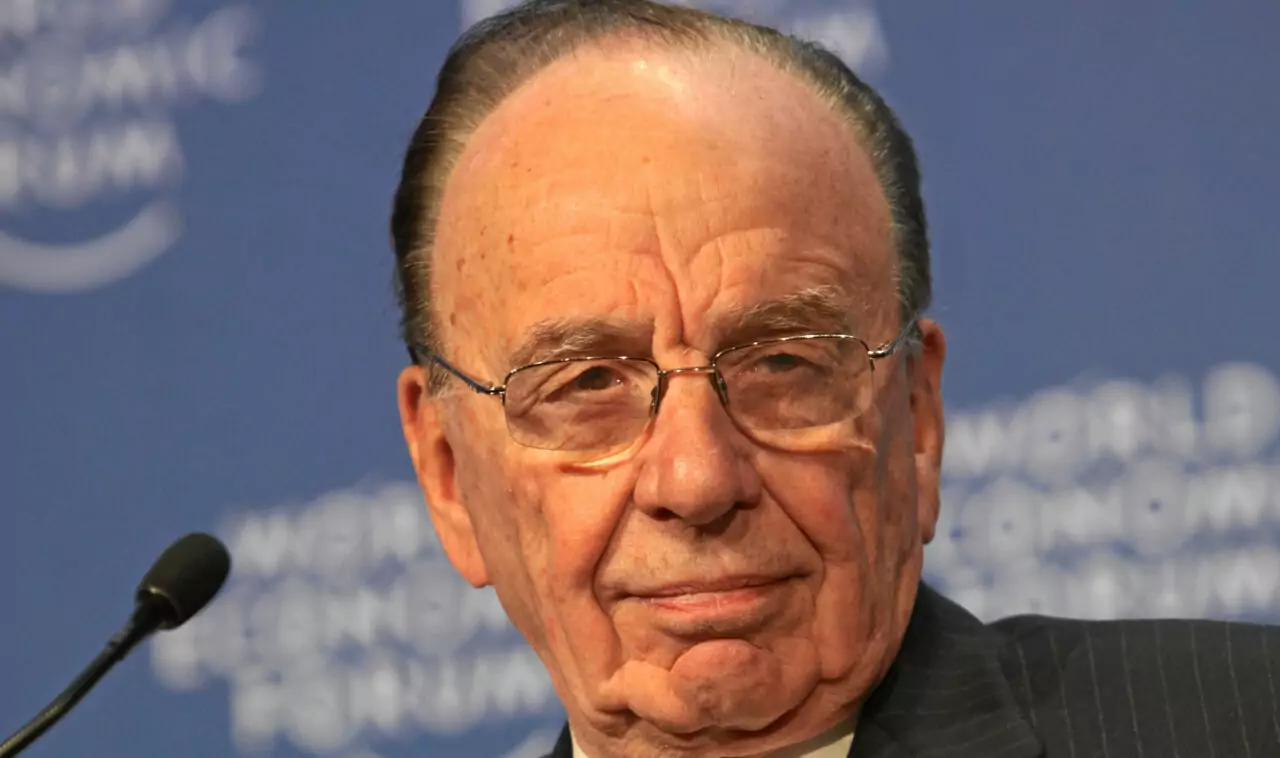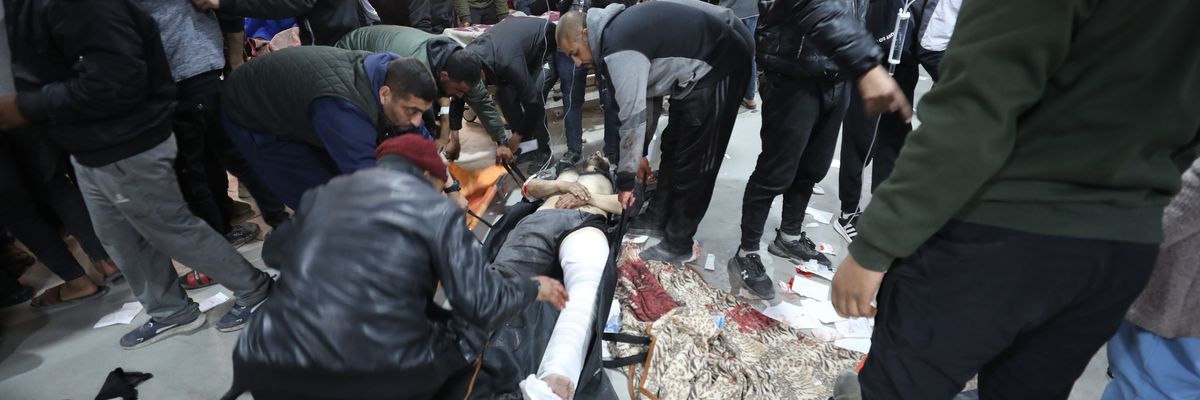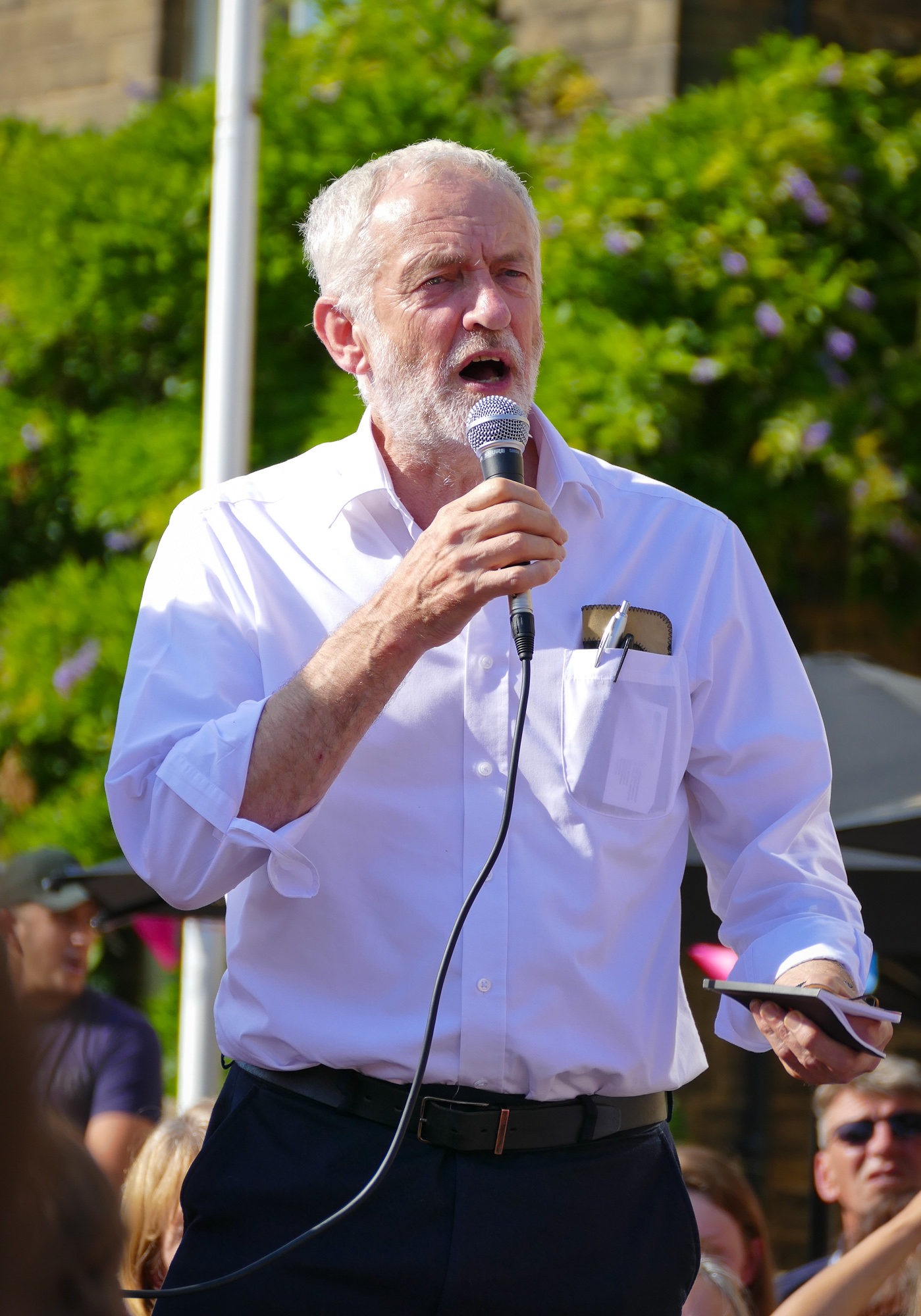Flour Massacre Called ‘Aid-Related Deaths’—Rather Than Part of Israel’s Engineered Famine
Original article by ROBIN ANDERSEN republished from FAIR under a Creative Commons Attribution-NonCommercial-NoDerivs 3.0 Unported License.

Over 100 Palestinians were killed and hundreds more wounded on February 29, when Israeli snipers opened fire on people approaching a convoy of trucks carrying desperately needed supplies of flour. The attack was quickly dubbed the flour massacre.
Corporate media reporting was contentious and confused, mired in accusations and conflicting details that filled the news hole, even as media downplayed the grave conditions in Gaza created by Israel’s engineered famine. With headlines layered in verbal opacity, the massacre prompted yet another egregious moment in media’s facilitation of Israel’s continuing genocide in Gaza.
Linguistic gymnastics

On the day of the massacre, the New York Times (2/29/24) published this contrivance:
“As Hungry Gazans Crowd a Convoy, a Crush of Bodies, Israeli Gunshots and a Deadly Toll”
It was met with ridicule as it slid across online platforms. Assal Rad (Twitter, 3/1/24), author and research director at the Iranian American Council, called the piece of work “a haiku to avoid saying Israel massacres Palestinians that they’re deliberately starving in Gaza.”
Another Times headline (2/29/24) read, “Deaths of Gazans Hungry for Food Prompt Fresh Calls for Ceasefire.” Nima Shirazi, co-host of the podcast Citations Needed (Twitter, 3/1/24), noted that “the New York Times just can’t bring itself to write clear headlines when Israeli war crimes are involved.” Shirazi offered this revision: “Israel Slaughters Starving People as It Continues Committing Genocide.”
Professor Jason Hickel (Twitter, 2/29/24), along with Mint Press‘s Alan MacLeod (2/29/24), flagged the use of the neologism “food aid–related deaths” when it turned up in a Guardian headline (2/29/24): “Biden Says Gaza Food Aid–Related Deaths Complicate Ceasefire Talks.” MacLeod noted, “Virtually the entire Western media pretend they don’t know who just carried out a massacre of 100+ starving civilians.”
Linguistic gymnastics—a longstanding plague pervading Western media coverage of Palestine (FAIR.org, 8/22/23)—were so popular in news headlines and reporting that Caitlin Johnstone (Consortium News, 3/1/24) compiled a list of them, adding “chaotic incident” (CNN, 2/29/24) and “chaotic aid delivery turns deadly” (Washington Post, 2/29/24) to those already mentioned.
Sana Saeed, media critic for Al Jazeera, decoded the latter kind of construction for AJ+ (3/29/24), arguing that such passive language has been used “consistently to sanitize the violence that a powerful state is unleashing against civilian populations.”
As the genocide enters its sixth month, media analysts, investigative reporters and social media users have become adept at recognizing pro-Israeli contortions and patterns of language that justify Israel’s war on Gaza. This has become an essential aspect in exposing Israel’s genocide.
‘Anarchy rules in Gaza’

The Economist (2/29/24), under the headline, “A New Tragedy Shows Anarchy Rules in Gaza: A Shooting and Stampede Kill 122 and Injure Hundreds,” went into the worst pro-Israel spin, with reporting that seemed to blame Palestinians for their own murders. Parroting Israeli press directives, the piece claimed Palestinians were killed by “trampling” each other in their own “stampede.”
The piece was written in literary prose: “Death descended on a coastal road in Gaza,” the reporter (not present at the scene) wrote. Then “catastrophe befell an aid convoy,” as if it merely happened upon bad luck.
Then the writer made a prediction: “As with many events in the war between Israel and Hamas, the facts are destined to remain fiercely contested.” That’s likely to come true, especially when major media outlets abdicate their responsibility for evaluating claims.
Timeline of changing denials

Many other writers and journalists have documented the string of vacillating Israeli statements that help explain the contorted reporting. Al Jazeera reporter Willem Marx (Twitter, 3/1/24) traced a timeline of how the Israeli military changed its story over the course of the day.
The IDF began by claiming there had been trampling and pushing that led to injuries around the aid truck. Then, hungry Palestinians had “threatened their soldiers,” or “appeared in a threatening manner,” so the IDF shot at them. Later that day, Israeli officials claimed there were two separate incidents, one that involved trampling and the other that led to shooting. By the end of the day, they alleged only to have provided support to a humanitarian convoy, and that no shots were fired at all by the military.
When the BBC (3/1/24) verified that a video released by the Israeli military exhibited four unexplained breaks in the footage and was therefore invalid, the outlet still used the passive voice, referring in the headline to “Gazans Killed Around Aid Convoy.” One sentence of the detailed, confused article quoted Palestinian journalist Mahmoud Awadeyah: “Israelis purposefully fired at the men…. They were trying to get near the trucks that had the flour.” Earlier, however, Awadeyah was problematized when identified “as a journalist for Al Mayadeen, a Lebanon-based news station whose broadcasts are sympathetic to groups fighting Israel.”
Independent and international media

If we compare corporate outlets to independent media, in which reporting was based on ground sources, humanitarian actors and aid workers, we find very different content.
Al Jazeera reporter Ismail al-Ghoul (2/29/24), who was at the scene of the massacre, said that “after opening fire, Israeli tanks advanced and ran over many of the dead and injured bodies. It is a massacre, on top of the starvation threatening citizens in Gaza.”
EuroMed staff (2/29/24) on the scene confirmed that the Israeli military had fired on starving Palestinians. EuroMed’s findings were summarized in a videotape by Palestinian news agency Quds News Network and posted by the Palestine Information Center (3/4/24).
Mondoweiss (3/4/24) reported details of the massacre from eyewitness accounts. One survivor recounted how an Israeli checkpoint “split the crowd in two,” preventing those who had entered the checkpoint from passing back to the northern side. Then Israeli soldiers opened fire on the crowd. International observers visited the injured survivors at al-Shifa’ Hospital, “confirming that the majority of wounds from the hundreds of injured people were due to live ammunition.”
In context of famine

Reporting in the alternative press also placed the massacre within the context of the rapidly increasing famine in Gaza.
The headline for the Electronic Intifada (2/29/24) read, “Palestinians Seeking Food Aid Killed as Israel Starves Gaza.” The outlet said an “engineered famine has taken hold in Gaza, with people resorting to eating wild plants with little nutritional value and animal feed to survive.”
Middle East Eye’s reporting (2/29/24) included the dire condition Palestinians are currently facing: “Much of Gaza’s population is on the brink of famine as a result of the Israeli blockade, according to the UN and other humanitarian organizations.”
The day of the massacre, Democracy Now! (2/29/24) opened its broadcast with a clear statement and the relevant context: “Israel Kills 104 Palestinians Waiting for Food Aid as UN Expert Accuses Israel of Starving Gaza.” Its first guest, UN special rapporteur on the right to food Michael Fakhri, said, “Every single person in Gaza is hungry.” He accused Israel of the war crime of intentional starvation. He emphasized that famine in the modern context is a human-made catastrophe:
At this point I’m running out of words to be able to describe the horror of what’s happening and how vile the actions have been by Israel against the Palestinian civilians.
Common Dreams (3/3/24) reported on Israel’s obstruction of aid convoys, and cited UNICEF on the deaths of children who
died of starvation and dehydration at a hospital in northern Gaza as Israeli forces continue to obstruct and attack aid convoys, fueling desperation across the territory…. People are hungry, exhausted and traumatized. Many are clinging to life.
It concluded, “These tragic and horrific deaths are man-made, predictable and entirely preventable.”
In the days before the massacre, numerous outlets had been documenting the growing famine looming over Gaza. This is the material independent media made use of for contextualizing the massacre.
The New York Times, on the other hand, put the massacre into an entirely different context. A piece (3/2/24) headlined “Disastrous Convey Was Part of New Israeli Effort for More Aid in Gaza,” cited as confirmation “Western diplomats, who spoke on condition of anonymity.” It said that international aid groups “suspended operations” because of “rising lawlessness,” as well as Israel’s refusal to “greenlight aid trucks.” It blamed starving Gazans by claiming that aid convoys had been looted either by “civilians fearing starvation” or by “organized gangs.”
‘How is this not a bigger story?’

As Common Dreams and Mondoweiss reported, the flour massacre was not the first time the IDF killed starving Palestinians, and it would not be the last. As Mondoweiss (3/4/24) put it: “In less than a week, Israel has committed several massacres against the hungry. On Sunday, March 3, Israel bombed an aid convoy, killing seven people.”
Quds News Network (3/2/24) reported that Israel targeted hungry civilians again at Al Rasheed Street in northern Gaza while they were waiting for humanitarian aid. And Quds (3/4/24) reposted Al Jazeera footage that captured the moments when Israel’s military opened fire at other hungry Gazans, this time at the Al Kuwait roundabout, as they looked for food aid.
Al Jazeera (3/6/24) continues to document the murders of Palestinians desperate for aid as they come under Israeli fire. On a longer videotape, a spokesperson for Human Rights Watch says these attacks violate ICJ orders:
The idea that these people are being killed as they scavenge for meager rations of food is just appalling, and is a reminder why there must be international immediate action to prevent further mass atrocities.
Following the Al Jazeera report, Assal Rad (Twitter, 3/6/24) expressed dismay:
Israeli attacks on Palestinians waiting for or attempting to get aid have repeatedly happened this week, yet there has been no media coverage since the massacre that killed over 100 people. Israel is attacking civilians it’s deliberately starving. How is this not a bigger story?
Normalizing starvation and massacres

Sana Saeed (Twitter, 3/4/24) observed:
So just to be clear: Much like how Israel normalized attacking and destroying hospitals, and it was accepted by the international community, Israel is now normalizing shooting and killing the people it is starving as they seek food.
Media have failed to inform the US public on the horrific conditions experienced by starving civilians in Gaza. They blamed Palestinians for their own deaths, covering for the Israeli military as it carried out a massacre. They further dehumanized Palestinians by characterizing starving people as an unruly mob who trampled one another.
To paraphrase Patrick Lawrence (Floutist, 11/16/23) on the distortion of language in defense of Israel’s violence against Palestinians: It corrupts our public discourse, our public space, and altogether our ability to think clearly. This corruption is as vital as US bombs to the Israeli genocide against Palestine: Without these verbal distortions that justify, distract, deny and consume corporate information spaces, the genocide could not be carried out.
FAIR’s work is sustained by our generous contributors, who allow us to remain independent. Donate today to be a part of this important mission.
Original article by ROBIN ANDERSEN republished from FAIR under a Creative Commons Attribution-NonCommercial-NoDerivs 3.0 Unported License.




